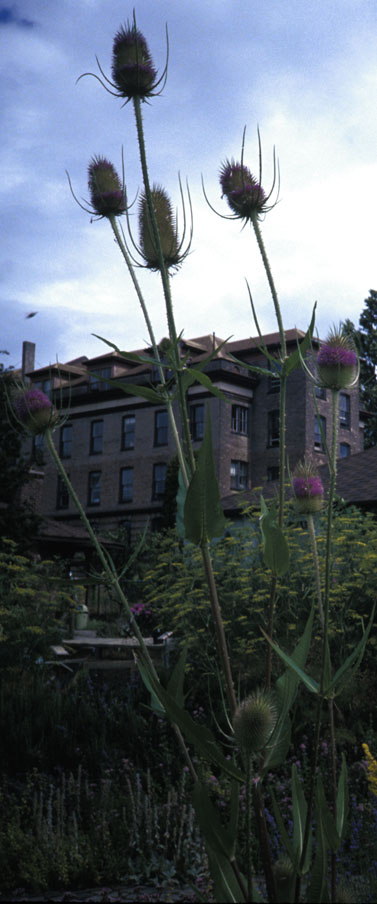
|
| Teasel; Dipsacus fullonum L. |
Teasel Family; DIPSACACEÆ
|
| A coarse biennial herb of thistle-like aspect, Teasel prominently stands out, well known because of its easily recognized features. Originally from the Old World, now it flourishes near freeways, by railroad tracks, in meadows and vacant lots in much of North America. Easily satisfied in its requirements, it only feels antipathetic to deep shade or wet soils. |
| The seedlings, usually appearing in fall, form a cluster of flat-lying, dark green, prickly, intensely bitter leaves, with attractive whitish veins down their middle. The taproot can descend nearly 2 and a half feet. After overwintering, Teasel sends forth stiff, straight leafy stems that stand stout, are coarse, raspy, rigidly upright, much branched, and can top-out at over 9 feet in height. The stem leaves clasp their bases together forming substantial cups that collect and hold rain. These rain pools or moats foil the efforts of nectar-seeking ants to reach the flowers. The tiny, much clustered, pinkish flowers yield good bee’s honey. The blooming period is July through September primarily. The bristly seedheads ripen up to 4 and a half inches long and 2 inches thick, constituting Teasel's "trademark" and real claim to fame. |
| How have humans regarded Teasel? It is far too bitter and scratchy to eat. It is too weedy in reproduction and viciously prickly to bear ornamental admittance in our gardens. Its medicinal value is negligible. It has very slight value as a dye plant. In the Language of Flowers it symbolizes misanthropy, austerity, and importunity. Hardly an appealing list of qualities! But, the unique seedheads save Teasel from total ignominy. They are cherished in dried decorations and have enjoyed a long, noble history in the craft of clothiers. For they are naturally perfect for "teasing" or "fleecing" or "fulling" or "brushing" to "raise the nap" on woolen cloth. Teasel has been much grown for this purpose. |
| Its name is sometimes spelled Teazel or Teazle. Other appellations quite as suggestive include: Carder's Thistle, Gypsy Combs, Barber's Brushes, Shepherd's Staff, Shepherd's Rod, Venus' Cup, or Venus' Basin. |
If you desire to rid yourself of it, do battle with a fork or sturdy spade, and leather gloves. Uproot specimens before they set seeds.
|
Originally published as the Seattle Tilth newsletter Weed of the Month in October 1986, along with an illustration drawn by Jerri Geer.
Back |
|
|

